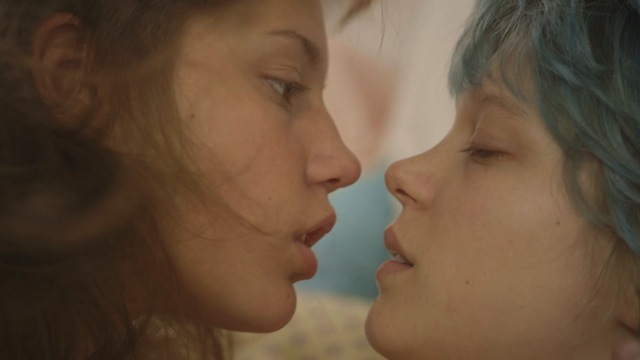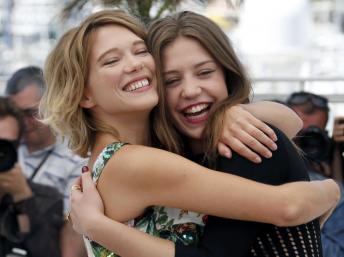Queer movies have an interesting history at awards shows. At least, when looking at one of the biggest accolades in the business, the Oscars, it’s always been a mixed bag in terms of how they treat movies about LGBTQ people. On the one hand, they’re usually nominated, and actors from Sean Penn to Hilary Swank have a history of picking up trophies for playing LGBTQ characters. On the other hand, they rarely win the top prize – most controversially with Brokeback Mountain being passed over for Crash in 2005.
Yet another one of the titans of film awards, the Cannes Film Festival, did decide to give its top prize, the Palme d’Or, this year to a queer-themed film. The French film Blue is the Warmest Color (or La Vie d’Adèle – chapitre 1 & 2), which focuses on a lesbian relationship between two adolescent girls – one in high school and one an art student – grabbed the coveted trophy this year. What’s particularly interesting is that, in an unusual move, Cannes jury chair Steven Spielberg decided that the award should be shared among the director and the two lead actresses, Léa Seydoux and Adèle Exarchopoulos because they were “central to the film’s success.”
The film is directed by Abdellatif Kechiche, a French-Tunisian director who has a history of films focusing on Arab minorities in the French suburbs, including Games of Love and Chance (2003) and The Secret of the Grain (2007). In an interview with The Upcoming, it’s noted that a lot of Kechiche’s films focus on a theme of “social justice,” but with regard to Blue is the Warmest Color, he talks more about the girls’ class divide than about homophobia as the source of that tension: “Emma belongs to an elite: intellectual, artistic. Each of my heroines is confined to her social class. The difficulties they have with their relationship… and ultimately what the film is about… is their social difference, since it generates a difference in their personal aspirations. ” He insisted he wanted to film it “like any other love story” rather than focus on any tension from homophobia, which he says “would be more or less tolerated, or understood, by the world around them,” and that he “has nothing militant to say about homosexuality.”

Even if Kechiche says he didn’t make the movie for political reasons having to do with sexual orientation, others don’t seem unwilling to use it for those purposes, with the Dhaka Tribune reporting that “the [Cannes] film festival’s director immediately urged the large crowds protesting against gay marriage in Paris to go and see it.” And even Kechiche himself, when reflecting on homophobia in Tunisia, says that he hopes “this is going to do Tunisian youth some good… a revolution isn’t complete unless it’s also a sexual revolution.”
And indeed, some reviewers seem to think the film does, in fact, due a lot to explore the myriad issues facing queer youth, from issues of labels to coming-out. As Shaun Munro’s review for The Film School Rejects puts it:
Blue leaps off to examine a wide gamut of emotional and social issues that define relationships, such as the problem that age differences can create, the fallacy of basing all your happiness on the partner you’re with and Adèle’s complicated placement on the sexual spectrum — is she a lesbian or bisexual? Also, Kechiche broaches the perception of lesbian relationships among youngsters – the gay panic among Adèle’s friends once they suspect her orientation is startling – and the inevitable awkwardness of deciding whether or not to come out to one’s parents, making for a hilariously awkward dinner scene at Adèle’s home.
All that being said, one particular aspect of the movie – the one that, unfortunately, seems to be getting all the press – doesn’t seem like it’d be too amenable to changing minds of anti-gay French citizens. What seems to be driving critics crazy about this film is the supposedly “infamous” 10-to-20-minute (reviews vary) sex scene between the couple. Honestly, it’s hard to say if some media’s quickness to call this “porn” is emphasis of a double standard; 10+ minutes is fairly long for a continuous sex scene, and recent controversies like the one over Blue Valentine’s rating show that the film world can still be prudish even about straight sex. But plenty of reviewers seem to be particularly weirded out by how much time the scene took up, often focusing attention away from the rest of the film. For example, New York Magazine’s Vulture even titles their article “The Ten-Minute Lesbian Sex Scene Everyone is Talking About At Cannes,” and seems more focused on audience reaction than anything else: “I clocked the first sex scene between Adèle and Emma — replete with fingering, licking, and, as a friend called it, ‘impressive scissoring’ — at an approximate ten minutes. Audience walkouts began around minute nine. That turned into spontaneous applause (and relieved laughter), when the women climaxed and finished a minute later.” Yet, they do ultimately conclude that the scene was a necessary element of the film.

Of course, it’s one thing for mainstream, mostly-straight reviewers to get upset by the idea that this is “porn.” But interestingly enough, Julie Maroh, the author of the graphic novel (Le Bleu est une couleur chaude) which inspired the film, seems to share some of their criticisms, at least with regard to the sex scene itself. She writes:
It appears to me that this was what was missing on the set: lesbians.
I don’t know the sources of information for the director or for the actresses (who are all straight, unless proven otherwise) and I was never consulted upstream. Maybe there was someone there to awkwardly imitate the possible positions with their hands, and/or to show them some porn of so-called “lesbians” (unfortunately it’s hardly ever actually for a lesbian audience). Because – except for a few passages – this is all that it brings to mind: a brutal and surgical display, exuberant and cold, of so-called lesbian sex, which has turned into porn, and made me feel very ill at ease. Especially when, in the middle of a movie theatre, everyone was giggling. The heteronormative laughed because they don’t understand it and find the scene ridiculous. The gay and queer people laughed because it’s not convincing at all, and found it ridiculous. And among the only people we didn’t hear giggling were the potential guys too busy feasting their eyes on an incarnation of their fantasies on screen… As a feminist and lesbian spectator, I cannot endorse the direction Kechiche took on those matters.
Yet, contrary to some of the reports, Maroh’s issue seems to be mainly with the sex scene, and overall, is not unhappy about the film:
Whatever it may be, I don’t see the movie as a betrayal. When it comes to adapting something, I believe that the notion of betrayal should be reconsidered… Kechiche went through the same process as any other reader, he entered it and identified in a unique way… The conclusion in Cannes is obviously wonderful and breathtaking… I remain absolutely overwhelmed, amazed, and grateful for these circumstances. Last night I realized this is the first time in Cinema’s history that a comic book has inspired a Palme D’Or movie and this idea petrified me. It’s a lot to carry.
Overall, it may indeed say a lot about the place of lesbians in media and culture that so much of the coverage of Blue is the Warmest Colour, from queer and straight media alike, seems to focus on the sex scene. In fact, though, many of the reviews stress the fact that the movie is about love — as opposed to sex — as the reason to see it. As The Guardian Film Blog’s headline puts it, “Blue is the Warmest Colour won at Cannes because it jumpstarts the heart,” noting the “passionate film-making,” “extraordinary and compelling intimacy” and “remarkable, courageous performances,” summarizing it as “a devastatingly emotional film about a love affair between two young women, with unforgettable notes of sensuality and sadness.”
Perhaps that should be the real take away from Blue‘s win at Cannes – that regardless of intensity of sexual content or lack thereof, queer films have proven their ability to tear at the heartstrings of viewers regardless of sexual orientation. And that’s the real reason they keep earning awards.

